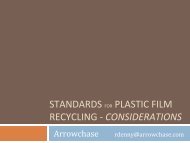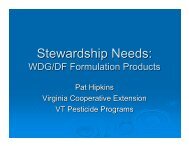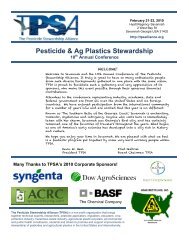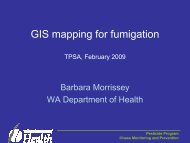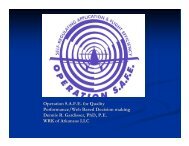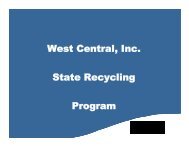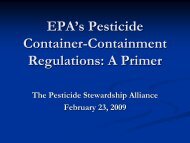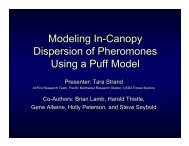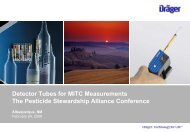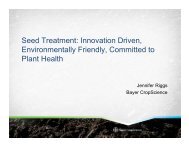Clean Sweep Programs - US Environmental Protection Agency
Clean Sweep Programs - US Environmental Protection Agency
Clean Sweep Programs - US Environmental Protection Agency
- No tags were found...
You also want an ePaper? Increase the reach of your titles
YUMPU automatically turns print PDFs into web optimized ePapers that Google loves.
The <strong>Clean</strong> <strong>Sweep</strong> ReportThe impression of many <strong>Clean</strong> <strong>Sweep</strong>managers is that a major obstacle to participation isover-coming distrust of government agencies andfear of retaliation. Many farmers have the perceptionthat they could be fined or otherwise punished ifit came to the attention of a government agency thatthey were storing chemicals, particularly canceledpesticides, on their property. Another fear is thatthey may be subject to an unwanted site inspectionor be placed on a “list” for some future enforcementaction. Some states have found that pre-registration,which helps them estimate the volume of wasteto be expected in a one-day collection event, is adeterrent to those who prefer to remain anonymous.To promote participation by agriculturalcommunities, some state <strong>Clean</strong> <strong>Sweep</strong> programspartner with industry. For example, Michiganenlisted the cooperation of Vriesland Grower’sCooperative, a 580-member cooperative with over60 years of service to growers. The cooperativeagreed to allow their facility to become a permanentcollection site for the <strong>Clean</strong> <strong>Sweep</strong> program, andduring its first year, collected 20 percent of all thepesticides in the entire state that year. States havealso relied on the good relationship betweenextension agents and growers to gradually diminishthe distrust of <strong>Clean</strong> <strong>Sweep</strong> programs.Many programs have seen an increase overtime in the volume of older pesticides collected.This may be due to the eventual participation byfarmers who held back until they saw that theirneighbors experienced no penalties or fines aftertaking part in a <strong>Clean</strong> <strong>Sweep</strong> program. Farmerstend to store unusable or canceled products untilthey have a safe way to dispose of them. Word ofmouth and other forms of communication eventuallyfilter through the agricultural community, and <strong>Clean</strong><strong>Sweep</strong> program managers have indicated that it maytake several collection events in the same areabefore the less trusting participate.After its 1998 program, Massachusettsconcluded that trust can be built by having regularand convenient collection events and developing andhighlighting partnerships with agricultural andpesticide user organizations. Under this approach,when a government agency is the initiator, it is listedas one of several sponsoring organizations. Ohio’sDepartment of Agriculture collaborates closely withcounty extension services, Farm Service Agencies,Soil and Water Conservation Districts, HealthDepartments and Solid Waste ManagementDistricts, and the Ohio EPA, with the Farm Bureauand commodity associations helping to publicize theprogram.Another potential barrier to participationmay be the location of the collection site. Farmersmay be unwilling to transport large quantities of toxicchemicals great distances to unfamiliar locations.Wisconsin records show the maximum distance theaverage farmer is willing to travel to participate in a<strong>Clean</strong> <strong>Sweep</strong> is 15 miles. One option for increasingparticipation is to expand service through satellitesites or mobile collection units.4.5 What are the disposal options fordioxin-containing wastes?Most pesticides can be disposed of at hightemperature hazardous waste incinerators orlandfilled at permitted hazardous waste landfills. Themain exception is the small number of pesticides thatmay contain dioxin, such as 2,4,5-T, Silvex, Ronneland pentachlorophenol. Under the federalhazardous waste regulations, these pesticidesgenerally fall under the “F027 code” (see box onfollowing page), which is identified as dioxin-listedwaste. Past <strong>Clean</strong> <strong>Sweep</strong> programs have receivedsmall amounts of these pesticides. Extrapolatingdata from programs which report quantities ofspecific pesticides collected leads to an estimate thatabout 300,000 pounds of dioxin-bearing pesticideshave been collected and disposed nationwide.53



